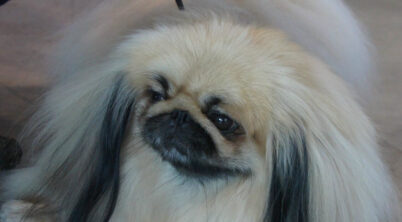The Pekingese, a toy breed with a long and illustrious history, possesses distinct physical characteristics that contribute to its charm. However, these same distinctive traits can, unfortunately, lead to specific health issues, especially concerning their eyes. Due to their compact facial structure, characterized by a short snout and large, prominent eyes, Pekingese are predisposed to various eye problems. These issues range from mere irritations to serious conditions that may require medical intervention.
Eye problems in Pekingese are not uncommon and can often be attributed to their brachycephalic nature—a term denoting their broad, short skull shape. The anatomical structure of their eyes and surrounding facial features lends itself to increased risks for conditions such as dry eye, where insufficient tear production leads to irritation and potential infection. Regular check-ups with a veterinarian are essential for early detection and management of such problems.
In addition to dry eye, Pekingese may also suffer from other issues like corneal ulcers due to their protruding eyes, which are more susceptible to injury. Guardians of these dogs should be vigilant in monitoring their pets for any signs of distress, such as excessive tearing, redness, or frequent pawing at the eyes. Proactive care, including routine cleaning and grooming, can help prevent complications that arise from common Pekingese eye problems, ensuring these cherished companions maintain good ocular health.
Table of Contents
Common Eye Conditions in Pekingese
Pekingese dogs are predisposed to several eye conditions due to their distinctive facial structure and genetic makeup. Awareness and early detection of these issues are crucial for maintaining their visual health.
Corneal Ulcers
Corneal ulcers occur due to damage on the surface of the eye’s cornea, often caused by trauma or abrasion from the Pekingese’s own hair. Symptoms include excessive tearing and redness. Immediate veterinary care is vital to prevent complications such as infections or blindness.
Entropion
Entropion is where the eyelid folds inward, causing eyelashes to irritate the cornea. This hereditary condition leads to tearing and potential corneal damage. Surgical correction may be required to prevent long-term harm.
Distichiasis and Trichiasis
Both conditions involve abnormal eyelash growth, with Distichiasis relating to extra eyelashes arising from unusual locations and Trichiasis implicating normal eyelashes directed towards the eyeball. They can cause discomfort, tearing, and keratitis due to irritation of the cornea.
Cataracts
Cataracts in Pekingese can lead to blindness if the lens of the eye becomes opaque. A genetic predisposition means regular eye examinations are essential for early detection and management, which could include surgery to restore vision.
Keratoconjunctivitis Sicca (Dry Eye)
Keratoconjunctivitis Sicca, commonly known as Dry Eye, results from inadequate tear production. It leads to a dry, inflamed cornea and conjunctiva. Symptoms include a thick discharge and trouble blinking. Treatment typically involves lubricating eye drops and sometimes surgery.
Diagnosing Eye Problems in Pekingese
Eye problems in Pekingese dogs are not uncommon due to their distinctive facial structure. When symptoms like pain, redness, or tearing arise, a visit to the veterinarian is crucial for a timely and accurate diagnosis.
Veterinary Examinations
A veterinarian or an ophthalmologist specializing in animals is the go-to professional when Pekingese dogs display signs of eye disorders. The initial examination will typically include a thorough review of the dog’s health history, followed by a physical evaluation focusing on the eyes. Any symptoms such as excessive tearing, redness, or signs of pain when the eyes are touched will be noted. Genetic factors are taken into account as well, since certain eye conditions can be hereditary.
Testing and Diagnosis
Diagnostic testing plays a pivotal role in detecting the exact eye problem in Pekingese. Two commonly used tests are:
- Schirmer Tear Test: This measures the eye’s tear production to diagnose dry eye conditions. A strip of paper is placed under the eyelid, and the wetted length is measured after a minute.
- Fluorescein staining: To check for corneal ulcers, a dye is applied to the eye, which highlights any damage on the surface under a special light.
If necessary, additional diagnostic procedures, such as intraocular pressure measurements or more in-depth genetic testing, might be conducted. Such methods help to determine the appropriate treatments to alleviate discomfort and preserve the Pekingese’s vision.
Treatment Options for Pekingese Eye Issues
When addressing eye issues in Pekingese dogs, it is vital to consider a range of treatment options suited to the specific condition. A comprehensive approach can include medications, surgery, and attentive home care prescribed by a professional veterinary ophthalmologist.
Medications and Eye Drops
For various infections and inflammatory conditions of the eye, veterinarians may prescribe antibiotics to tackle bacterial infections. In cases of inflammation, anti-inflammatory drugs can help to reduce swelling and alleviate pain. In addition, artificial tears may be recommended for lubrication and to aid in healing processes, while an ophthalmic ointment may be used to treat corneal injuries.
- Antibiotics: Specifically for bacterial infections.
- Anti-Inflammatory Drugs: To decrease inflammation and discomfort.
- Artificial Tears: To lubricate dry eyes and prevent irritation.
- Ophthalmic Ointment: For healing corneal abrasions.
Surgical Interventions
If medicinal treatments are not sufficient, or in cases of structural problems like cherry eye, a Pekingese may require surgical procedures. Surgery can restore function or prevent further damage to the eyes. Procedures should be performed by a specialized veterinary ophthalmologist to ensure the best outcome.
- Cherry Eye Surgery: To reposition or remove the prolapsed gland.
- Corneal Surgery: For severe injuries or deformities of the cornea.
Home Care Strategies
Apart from medical and surgical interventions, proper home care can prevent aggravation of current conditions and minimize the risk of future issues. Owners should maintain a clean environment, regularly trim hair around the eyes to prevent irritation, and closely follow veterinary guidance for ongoing care.
- Regular cleaning: Gently clean around the eyes to remove discharge.
- Hair management: Keep hair trimmed to avoid ocular irritation.
Preventing Eye Problems in Pekingese
Proactive measures can significantly reduce the risk of eye problems in Pekingese. Regular veterinary oversight, alongside meticulous grooming and considerate environmental management, form the pillars of prevention.
Routine Check-Ups
Veterinary Attention: Regular check-ups are crucial. These appointments allow a veterinarian to catch early signs of eye problems, such as abnormal discharge or changes in the eye’s appearance. Pekingese should be screened for common issues, including those caused by their brachycephalic head shape, which can exacerbate eye problems.
Proper Grooming
Grooming to Avoid Injury:
- Cleanliness: Keeping the Pekingese’s eye area clean prevents irritation from foreign particles.
- Eyelash Care: Special attention is needed to prevent eyelashes from rubbing against the eyes, which is common due to their distinct facial structure.
- Allergy Management: A Pekingese with allergies may require more frequent grooming to remove allergens from the fur and face.
Environmental Management
Reducing Hazards for Eye Health:
- Home Safety: Ensure the Pekingese’s living area is free from sharp objects and other hazards that can cause injury.
- Dietary Considerations: A balanced diet supports overall health, which can indirectly benefit eye health.
- Brachycephalic Awareness: The shortened facial structure of a Pekingese should prompt owners to minimize situations where the eyes could be injured, considering their prominence and vulnerability.
The Role of Genetics and Breeding in Eye Health
Pekingese Dogs have distinct facial and ocular characteristics that stem from selective breeding practices. These dogs are categorized as a brachycephalic breed due to their short nose and flat face, traits which are linked to various eye problems, including Brachycephalic Ocular Syndrome.
- Genetic Predisposition: This breed is genetically predisposed to certain hereditary conditions. For instance, they may develop Progressive Retinal Atrophy (PRA), a degenerative disease affecting the retina, which can lead to blindness.
- Structural Complications: Due to the short nasal bones and a prominent ocular structure, Pekingese are at an increased risk of ocular proptosis, where the eyeball may dislodge from the socket following minor trauma. Similarly, the compacted skull structure can lead to shallow eye sockets and eyelid abnormalities.
Breeding practices have unfortunately amplified these risks. Breeders selecting for the Pekingese’s distinctive facial features may inadvertently prioritize appearance over health, perpetuating the issues associated with brachycephalic breeds.
- Selective Breeding: Efforts to decrease these risks involve responsible breeding practices that prioritize health. This includes screening for common genetic eye issues and modifying breeding standards to support the overall well-being of Pekingese Dogs.
In recognition of these concerns, responsible breeding and informed care are essential to mitigating the potential complications related to the genetic and structural predispositions of the Pekingese breed. It is imperative for current and prospective Pekingese owners to understand these genetic factors to ensure the health and vitality of these cherished companions.
* Banner photo by Wendy Berry, cropped | Some rights reserved








